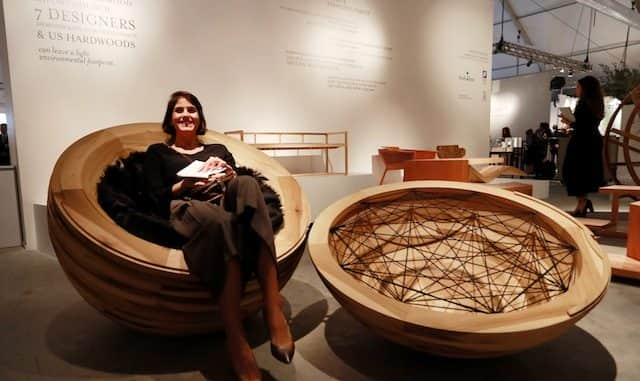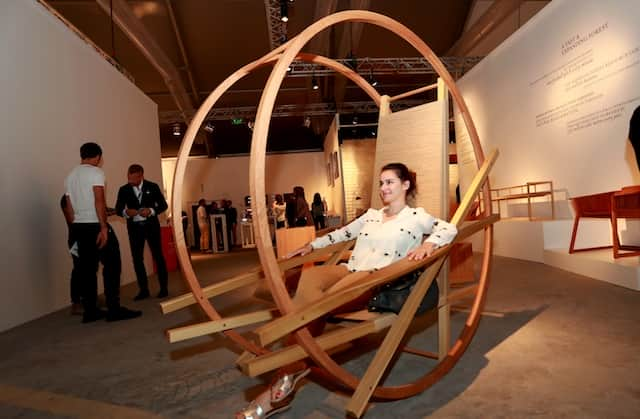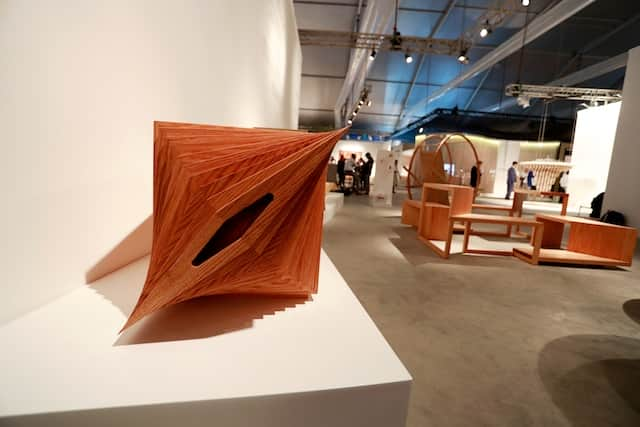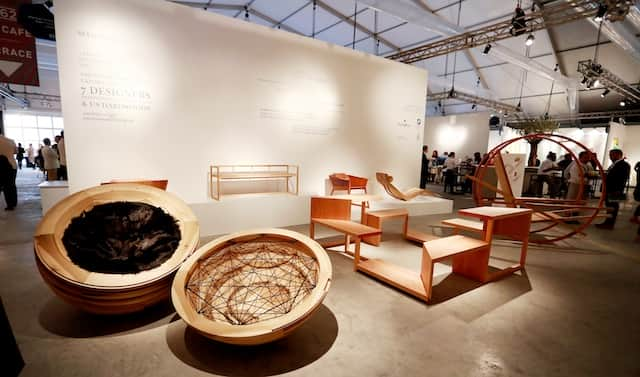
It would take a mere 3.32 seconds for all the American hardwood used to make the seven pieces to be replaced in the U.S. forest
The American Hardwood Export Council (AHEC), the leading international trade association for the American hardwood industry, has unveiled its ‘Seed to Seat’ furniture collaborative at ‘Design Days Dubai’, the Middle East and South Asia’s only annual fair dedicated to collectible modern and contemporary design works, which opened yesterday (March 14, 2017) and is due to run until March 17. Given an open brief and asked to design ‘something to sit on’, the designers have worked closely with AMBB Furniture Manufacturing and created seven unique pieces using American tulipwood, red oak and cherry. The project in the Middle East is the second phase of ‘Seed to Seat’, which was initially launched in Australia and New Zealand last year.
 The seven seats, which were designed and made by some of the most prominent and exciting designers based in the UAE, are on show in a creative display that highlights the sustainable credentials of the American hardwood resource. The designers involved with ‘Seed to Seat’ Dubai are Fadi Sarieddine (Fadi Sarieddine Design Studio), Anna Szonyi (Studio Anna Szonyi), Tarik Al Zaharna (T.ZED Architects), Bruce Paget (Heriot-Watt University – Dubai Campus), George Kahler (Kahler Design), Pallavi Dean (Pallavi Dean Interiors) and Hana Akram (Studio EM). Aiming to demonstrate that sustainability can have substance, AHEC is developing full environmental profiles for each of the finished pieces using its ground-breaking Life Cycle Assessment (LCA) research.
The seven seats, which were designed and made by some of the most prominent and exciting designers based in the UAE, are on show in a creative display that highlights the sustainable credentials of the American hardwood resource. The designers involved with ‘Seed to Seat’ Dubai are Fadi Sarieddine (Fadi Sarieddine Design Studio), Anna Szonyi (Studio Anna Szonyi), Tarik Al Zaharna (T.ZED Architects), Bruce Paget (Heriot-Watt University – Dubai Campus), George Kahler (Kahler Design), Pallavi Dean (Pallavi Dean Interiors) and Hana Akram (Studio EM). Aiming to demonstrate that sustainability can have substance, AHEC is developing full environmental profiles for each of the finished pieces using its ground-breaking Life Cycle Assessment (LCA) research.
 “Our collaboration with the seven designers and AMBB Furniture Manufacturing has resulted in a fascinating approach to working with timber, which has made a comeback over the past few years. This unique exercise has not only thrown the spotlight on the beauty of American hardwoods but it has also helped the designers explore the creative potential of underutilized and yet readily-available hardwoods from America,” said Roderick Wiles, AHEC Director for Africa, Middle East, India and Oceania. “Seed to Seat was conceived as a way for AHEC to collaborate with high profile designers and to introduce them to U.S. hardwood species that are less well-known in their markets. With the unveiling of these remarkable pieces at Design Days Dubai, the project reconfirms Dubai’s position as a center for design.”
“Our collaboration with the seven designers and AMBB Furniture Manufacturing has resulted in a fascinating approach to working with timber, which has made a comeback over the past few years. This unique exercise has not only thrown the spotlight on the beauty of American hardwoods but it has also helped the designers explore the creative potential of underutilized and yet readily-available hardwoods from America,” said Roderick Wiles, AHEC Director for Africa, Middle East, India and Oceania. “Seed to Seat was conceived as a way for AHEC to collaborate with high profile designers and to introduce them to U.S. hardwood species that are less well-known in their markets. With the unveiling of these remarkable pieces at Design Days Dubai, the project reconfirms Dubai’s position as a center for design.”
 With Seed to Seat, AHEC aims to identify the true environmental impact of design and build on its extensive work with Life Cycle Assessment (LCA). Incorporating AHEC’s LCA research for 19 American hardwood species and all data concerning materials, energy usage, transport and wastage, which was recorded during the manufacturing process, AHEC is able to assess the full environmental impact for each finished piece. For each design, AHEC has also calculated how many seconds it would take for the wood used to make the piece to be replaced through natural regeneration in the U.S. hardwood forest. Factoring in the size of the forest, annual harvest rates, natural mortality and regeneration rates, AHEC has calculated that it would take a mere 3.32 seconds for all the wood used to grow in the forest.
With Seed to Seat, AHEC aims to identify the true environmental impact of design and build on its extensive work with Life Cycle Assessment (LCA). Incorporating AHEC’s LCA research for 19 American hardwood species and all data concerning materials, energy usage, transport and wastage, which was recorded during the manufacturing process, AHEC is able to assess the full environmental impact for each finished piece. For each design, AHEC has also calculated how many seconds it would take for the wood used to make the piece to be replaced through natural regeneration in the U.S. hardwood forest. Factoring in the size of the forest, annual harvest rates, natural mortality and regeneration rates, AHEC has calculated that it would take a mere 3.32 seconds for all the wood used to grow in the forest.
 “The American hardwood forest covers 120 million hectares. Hardwood trees are selectively harvested and replaced with new growth through natural regeneration. Regeneration outstrips harvest and, as a result, this vast resource increases by 130 million cubic metres every year. For illustrative purposes, this is equivalent to around 4.5 million 40 foot containers in volume. Our initial analysis of the entire project revealed that a total of 1.83 cubic metres of solid lumber was used to make the pieces. Significantly, due to the carbon storage properties of wood, for the duration of their lifetimes, all of the seats will keep a total of 673.26kg of CO2 equivalent out of the atmosphere. This project then has enabled us to highlight the full environmental impact of the designs produced and the importance of material selection. Ultimately, we hope this paves the way for a more scientific approach towards specification of timber,” concluded Wiles.
“The American hardwood forest covers 120 million hectares. Hardwood trees are selectively harvested and replaced with new growth through natural regeneration. Regeneration outstrips harvest and, as a result, this vast resource increases by 130 million cubic metres every year. For illustrative purposes, this is equivalent to around 4.5 million 40 foot containers in volume. Our initial analysis of the entire project revealed that a total of 1.83 cubic metres of solid lumber was used to make the pieces. Significantly, due to the carbon storage properties of wood, for the duration of their lifetimes, all of the seats will keep a total of 673.26kg of CO2 equivalent out of the atmosphere. This project then has enabled us to highlight the full environmental impact of the designs produced and the importance of material selection. Ultimately, we hope this paves the way for a more scientific approach towards specification of timber,” concluded Wiles.
For more information, please see: www.seedtoseat.info.
me+mine by Pallavi Dean
The dominant theme of me+mine is transformation. Look at it when it’s closed and you wouldn’t know it’s a chair. It’s a beautiful, sculptural sphere that demands attention because of the precise curves and the striations of the tulipwood; when you peel it apart it transforms into an invitation for two people to sit down and interact.
1.03 cubic metres of American tulipwood (Liriodendron tulipifera) were used to make me + mine. All the tulipwood used to make me + mine would be replaced by new growth in the forest in just 2.00 seconds. Due to the carbon storage properties of wood, for the duration of its lifetime, me + mine will keep 339.41 kg of CO2 equivalent out of the atmosphere.
Float by George Kahler
Float facilitates relaxation. It offers perfect equilibrium to its user. Linking the spiritual properties of timber, our need for meditation in today’s busy world and the form of Le Courbusier’s LC4, Kahler Design’s Float gives the user a serene moment of balance promoting a meditative state whilst connecting with the life giving properties of timber.
0.26 cubic metres of American tulipwood (Liriodendron tulipifera) were used to make Float. All the tulipwood used to make Float would be replaced by new growth in the forest in just 0.50 seconds. Due to the carbon storage properties of wood, for the duration of its lifetime, Float will keep 16.66 kg of CO2 equivalent out of the atmosphere.
Ribbench by Tarik Al Zaharna
Ribbench is yet another demonstration of the strength of tulipwood. Whilst technically a hardwood, tulipwood is a softer material that has been detailed into an interlocking main frame. With the intention of encouraging users to take a closer look at the seat, the ‘slim’ construction spans 1.55 metres in length as a result of an accumulation of intricate inter-locking details.
0.02 cubic metres of American tulipwood (Liriodendron tulipifera) and 0.01 cubic metres of American red oak (Quercus spp.) were used to make Ribbench. All the tulipwood and red oak used to make Ribbench would be replaced by new growth in the forest in just 0.06 seconds. Due to the carbon storage properties of wood, for the duration of its lifetime, Ribbench will keep 17.74 kg of CO2 equivalent out of the atmosphere.
Rock ‘n’ Roll Chair by Fadi Sariedinne
The chair pushes the boundary of the classic rocking chair by completing the arc of the legs, thus creating a full circle. The resulting shape is a cocoon like structure engulfing its user. The chair with its full circular shape has the ability to roll to become a stable chaise longue. The double circles are intersected by a series of lines generating the seat, back and arm rests. All connections are done using dowels and tie rope with no screws or nails.
0.03 cubic metres of American tulipwood (Liriodendron tulipifera) and 0.13 cubic metres of American red oak (Quercus spp.) were used to make the Rock ‘n’ Roll chair. All the tulipwood and red oak used to make the Rock ‘n’ Roll chair would be replaced by new growth in the forest in just 0.22 seconds. Due to the carbon storage properties of wood, for the duration of its lifetime, the Rock ‘n’ Roll chair will keep 42.41 kg of CO2 equivalent out of the atmosphere.
Heriot Watt chair by Bruce Paget
The aesthetic for the Heriot Watt chair is loosely inspired by the prevalent method and aesthetic method of construction in contemporary Dubai – the concrete frame and rain screen combination. The structure and skin elements in the design are made visually distinct – the thinness of the supported elements contrasting with the visually heavier structure – the intention being to communicate to the viewer the relationship of the supporting and supported components and in doing so illustrate timbers versatility in fulfilling both the practical and aesthetic elements of a design.
0.04 cubic metres of American cherry (Prunus serotina) were used to make the Heriot Watt chair. All the cherry used to make the Heriot Watt chair would be replaced by new growth in the forest in just 0.20 seconds. Due to the carbon storage properties of wood, for the duration of its lifetime, the Heriot Watt chair will keep 16.89 kg of CO2 equivalent out of the atmosphere.
PAUSE by Hana Akram
PAUSE is a modular seating system that aims to connect literally and figuratively. It explores the hidden potential of human interaction despite Dubai’s fast-paced lifestyle and asks its citizens to PAUSE, connect and play. It is comprised of a pair of two combinable shapes to be set up in various layouts serving a variety of purposes. PAUSE also utilized several seating heights, allowing the user to select any preferred surface as they wish. It is minimal and modern enough to suit just about any interior space, especially common spaces where connection between users is key.
0.23 cubic metres of American red oak (Quercus spp.) were used to make PAUSE. All the red oak used to make PAUSE would be replaced by new growth in the forest in just 0.26 seconds. Due to the carbon storage properties of wood, for the duration of its lifetime, PAUSE will keep 189.41 kg of CO2 equivalent out of the atmosphere.
OBLONG by Anna Szonyi
The design is a formal experimentation, which aims to bridge the tension and misfit between organic and engineered objects as inspired by the ‘Seed to Seat’ brief. It captures an intermediate formal state during the physical transformation of an organically-shaped object to a perfect geometric cube. It is a multi-purpose piece: a sculpture and a functional piece of furniture that can be a stool like seat or even a side table. OBLONG is made from American red oak, selected for its grain and light color tone, which match the concept.
0.08 cubic metres of American red oak (Quercus spp.) were used to make OBLONG. All the red oak used to make OBLONG would be replaced by new growth in the forest in just 0.09 seconds. Due to the carbon storage properties of wood, for the duration of its lifetime, OBLONG will keep 50.74 kg of CO2 equivalent out of the atmosphere.
About AHEC
The American Hardwood Export Council (AHEC) is the leading international trade association for the U.S. hardwood industry, representing the committed exporters among U.S. hardwood companies and all the major U.S. hardwood production trade associations. AHEC runs a worldwide programme to promote American hardwoods in over 50 export markets, concentrating on providing architects, specifiers, designers and end-users with technical information on the range of species, products and sources of supply. In addition, AHEC also produces a full range of technical publications. For more information, please visit: www.americanhardwood.org.
About Design Days
Design Days Dubai is presented under the Patronage of H.H. Sheikh Hamdan Bin Mohammed Bin Rashid Al Maktoum, Crown Prince of Dubai and is held in partnership with the Dubai Culture and Arts Authority, the Emirate’s dedicate Authority for culture, arts and heritage. Returning for its sixth edition, Design Days Dubai is the Middle East and South Asia’s only annual fair dedicated to collectible modern and contemporary design works, this year taking place from March 14-17, 2017. Positioned as a fair of discovery, the fair’s unique format provides an international platform for the region’s emerging design studios and furniture makers to debut their contemporary designs, featuring them alongside an eclectic mix of the world’s leading design galleries. Running parallel to the exhibitor line-up is a programme of special projects, talks, workshops and guided tours allowing visitors to discover and engage with the design community and the works on display.
A pillar event of Art Week, Design Days Dubai this year moves to a new location, Dubai Design District (d3), the home for the region’s design and creative industries. As part of the new move, the fair has commissioned the Dubai-based architecture practice, a hypothetical office, to add a series of new features to the venue including a new face and floor plan. Design Days Dubai has the continued support of returning sponsors since its 2012 launch edition, including the Dubai Culture & Arts Authority, Van Cleef & Arpels, Audi, and d3. For more information, please visit: www.designdaysdubai.ae
